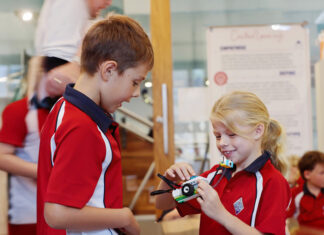The increase in visitation to not only our local beaches, but also our beaches around Australia, make it obvious that we in lifesaving, keep abreast of modern technology and rescue procedures.
This year, the Noosa club will celebrate the 21st birthday of a rescue system that is unique in Australia; the Three Tower Concept.
With two towers on Noosa’s Main Beach manned by Lifesavers and Lifeguards and the third, in the mouth of the Noosa River manned by Noosa Coast Guard: this concept, the first of its type to be built on the beaches of Australia, has now paid for itself many times over.
The overall cost of $60,000 fades into insignificant when we consider the lives that have been saved as a result of this concept.
It is now obvious that with the roving patrols being on the increase, a major factor is now Elevation and Communication.
By this we mean high towers, manned by patrol members equipped with radios and the now essential powerful, binoculars and telephones. During the last several months, mother nature has imposed upon us a new sand bank, that during low tide, can be seen stretching west some 100 meters from the Second Point in National Park. With this bank being incredibly shallow at low tide, it becomes something of a novelty attraction for visitors wishing to go wading in the shallow waters: this will sometimes lead to all sorts of problems. In particular when children are involved.
It is times like this, that high- powered binoculars become an essential piece of equipment: with these it is possible for the Tower patrol to properly assess the condition of people at the end of the bank. The old days, when those in trouble would raise their hand has for some, become a thing of the past: this is why binoculars must be top grade. An experienced patrol member, will be quickly able to assess body and head movements and thus evaluate their state of mind: is it panic or play?
Many of todays’ procedures would have been impossible in the old days, when lifesavers walked the beaches between the flags, with virtually only the reel, line and belt and a small tower. No radios telephones or binoculars.
The first steps towards the Three Tower Concept came in 1978, when as a member of the Australian delegation to the World Lifesaving Congress USA, I was requested by officials of both Sunshine Coast Branch and Queensland State Centre, to have a close look at the American Tower system being used on the famous Huntington Beach: the reason being that visitation of our beaches was on the increase. With this being a reality, our people were starting to look at some type of Extended Bathing reserve, which would see the red and yellow flags greatly extended on selected beaches: this would only occur when beach and safe surf conditions permitted.
State officials already had several beaches in mind, one of which was Noosas Main Beach. It was quite obvious, that with Noosas First and Second Points, calm conditions prevailed on most occasions. When this occurs, it would be possible to patrol with one flag in front of the club house and the second in a close proximity of the rock wall.
On arrival at the Congress, the team manager made this known to the American delegates and two days later, during a rest break, I found myself in a patrol vehicle with American lifeguards, being driven along the famous Huntington Beach: a beach that extended for 13.7 kilometres. On this vast stretch of beach were thousands of beach goers: and all under the observation of the tower system.
When I remarked on the crowd size the driver replied, “Yeah Aussie but today it’s a bit quiet there is only about 60,000. On a big day there will be upward of 100,000:like we had on Mother’s Day. People everywhere- and,” he added with a laugh, “some of them don’t even speak English.” Stepping out of the vehicle, I walked into the water for a better view and just then I heard a voice behind me say, “I know what thinking. This tower system is perfect for Noosas Main Beach.” On turning, I found it was a team mate and member of National Council(our governing body) Trevor Hoskins of the Gold Coast. “When you get home, get straight on to it-don’t muck around.”
Following this, Huntington officials made themselves available for further discussions and also presented me with a set of plans for the construction of the towers. I was totally convinced that this system was the way to go. Study the plans, and make alterations to cover our needs. However, on arriving home I hit a brick wall: it was a “Yank idea” and some officials just were not interested. On presenting my four- page report, I stood stunned as a high-ranking executive, without reading a word, threw it into a rubbish bin, stating as he did so, “Listen mate we teach the Yanks, they don’t teach us.”
The years dragged on, then suddenly in 1991, right out of the blue came a phone call from clubmate and Noosa Lifeguard Peter Whadcoat. “Listen mate, are you still interested in that tower system for Noosa Main Beach?’’ Answering in the positive, he then informed me that he had friends who were interested and felt that this time we should get the support. He had held discussions with State Centre, (the governing body of both Lifesaving and Lifeguards) and Coast Guard and their response, was full support. Three towers were proposed. One tower front of Noosa Club would be manned by the lifesavers, the second on the rock wall, at the end of Main Beach, by lifeguards and the third in the river mouth by Coast Guard.
The manning of the third tower in the position suggested, Coast Guard was in complete support. This would give them an all- weather surveillance- second to none of the Noosa Bar. A meeting was called and representatives of all parties involved were named. The group would be known as the Noosa Beach and Bar Safety Committee (N.B.B.S.C.) with representation as followers. Coast Guard, John Mountford (Chairman) Bill Asmar and Bruce Murrie, Noosa Shire Lifeguard Service, Peter Whadcoat and Scott Braby, Noosa Heads S.L.S.C.Doug Barnes and Ron Lane.
For the design and construction, local architects Hurst and Harris were named and the appointed builder was H & H Boreham. All towers would contain telephones, binoculars and a radio system that would give direct communication to emergency services such as, Jet Boats, Rescue Helicopters, Police and Paramedics. The modern rescue craft, the Jet Rescue Ski has since been added. The overall tag was $61,480, thus giving an individual cost of approximately $20,000.A major highlight was the fact that all three groups would be working in harmony.
Proud to say that no such system exists anywhere else on the Australian Coast. The important factor of Elevation and Communication cannot be stressed enough. All towers should be of a good height, have verandas and be fully equipped with the latest radios. With such a system in place, absolute surveillance for Noosa Beach and Bar, North Shore, plus a section of National Park is now a possibility. The lives saved by this system is now many.







